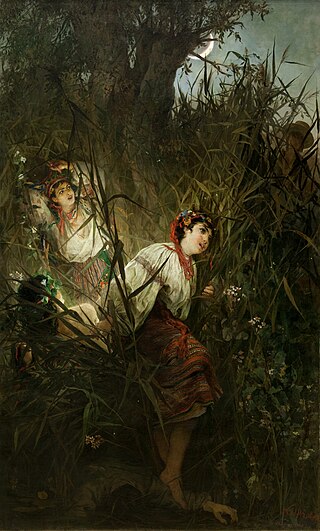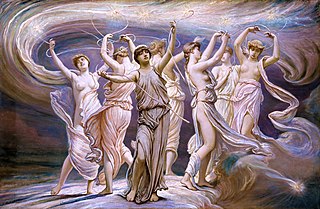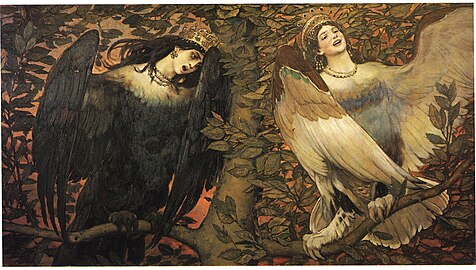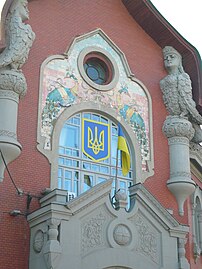
In Greek mythology, Alcyone and Ceyx were a wife and husband who incurred the wrath of the god Zeus for their romantic hubris.
Finnish mythology commonly refers of the folklore of Finnish paganism, of which a modern revival is practiced by a small percentage of the Finnish people. It has many shared features with Estonian and other Finnic mythologies, but also with neighbouring Baltic, Slavic and, to a lesser extent, Norse mythologies.

Svarog is a Slavic god of fire and blacksmithing, who was once interpreted as a sky god on the basis of an etymology rejected by modern scholarship. He is mentioned in only one source, the Primary Chronicle, which is problematic in interpretation. He is presented there as the Slavic equivalent of the Greek god Hephaestus. The meaning of his name is associated with fire. He is the father of Dazhbog and Svarozhits.

The world tree is a motif present in several religions and mythologies, particularly Indo-European, Siberian, and Native American religions. The world tree is represented as a colossal tree which supports the heavens, thereby connecting the heavens, the terrestrial world, and, through its roots, the underworld. It may also be strongly connected to the motif of the tree of life, but it is the source of wisdom of the ages.

Other than the many gods and goddesses of the Slavs, the ancient Slavs believed in and revered many supernatural beings that existed in nature. These supernatural beings in Slavic religion come in various forms, and the same name of any single being can be spelled or transliterated differently according to language and transliteration system.

The samodiva, samovila or vila, are woodland fairies or nymphs found in South and West Slavic folklore.
Enchantress most commonly refers to:

In Slavic mythology and folklore, the Firebird is a magical and prophetic glowing or burning bird from a faraway land which is both a blessing and a harbinger of doom to its captor.

The Legend of the Invisible City of Kitezh and the Maiden Fevroniya is an opera in four acts by Nikolai Rimsky-Korsakov. The libretto was written by Vladimir Belsky, and is based on a combination of two Russian legends: those of Saint Fevroniya of Murom and of the city of Kitezh, which became invisible when attacked by the Tatars. The opera was completed in 1905, and the premiere performance took place at the Mariinsky Theatre in St. Petersburg, on February 7, 1907, the last in Rimsky-Korsakov's lifetime.

Sirin is a mythological creature of Rus' legends, with the head of a beautiful woman and the body of a bird, borrowed from the siren of the Greek mythology. According to myth, the Sirin lived in Iriy or around the Euphrates River.

Gamayun is a prophetic bird of Russian folklore. It is a symbol of wisdom and knowledge and lives on an island in the mythical east, close to paradise. She is said to spread divine messages and prophecies, as she knows everything of all creation, gods, heroes, and man. Like the Sirin and the Alkonost, other creatures likewise deriving ultimately from the Greek myths and siren mythology, the Gamayun is normally depicted as a large bird with a woman's head. In the books of the 17th-19th centuries, Gamayun was described as a legless and wingless bird, ever-flying with the help of a tail, foreshadowing the death of statesmen by her fall.

The Feather of Finist the Falcon or Finist the Falcon is a Russian fairy tale collected by Alexander Afanasyev in Narodnye russkie skazki. It is Aarne–Thompson type 432, the prince as bird. Other tales of this type include The Green Knight, The Blue Bird, and The Greenish Bird.

Alcyone, in Greek mythology, was the name of one of the Pleiades, daughters of Atlas and Pleione or, more rarely, Aethra. She attracted the attention of the god Poseidon and bore him several children, variously named in the sources: Hyrieus, Hyperenor, and Aethusa; Hyperes and Anthas; and Epopeus. By a mortal, Anthedon, Alcyone became the mother of the fisherman Glaucus, who was later transformed into a marine god.

Kostroma is an East Slavic fertility goddess. Her name is derived from костёр (kostyor), the Russian word for "bonfire".

Folklore of Russia is folklore of Russians and other ethnic groups of Russia.

Deathless is an alternate history novel by American writer Catherynne M. Valente, combining the Russian fairy tale The Death of Koschei the Deathless with the events and aftermath of the Russian Revolution. The novel follows the life of Marya Morevna as she transforms from a young child witnessing the revolution to her newfound position as bride after her marriage with Koschei, Tsar of Life. The book is divided into six parts and is told primarily through the third person perspective of Marya Morevna, however, it does feature other characters such as Ivan Tsarevich.

There are a number of deities and personifications associated with seasons in various mythologies, traditions, and fiction.

"Lighthouse" is a song by Croatian singer Nina Kraljić released on March 9, 2016. It represented Croatia in the Eurovision Song Contest 2016.
The Slavic creation myth is a cosmogonic myth in Slavic mythology that explains how the world was created, who created it, and what principles guide it. This myth, in its Christianized form, survived until the nineteenth and twentieth century in various parts of the Slavdom in chronicles or folklore. In the Slavic mythology there are three versions of this myth: the first version is the so-called earth-diver myth, which intertwines two main motifs: the dualistic motif – the cooperation of God and the Devil is required to create the world, and the oceanic motif – the pre-existence water, where the seed of the Earth comes from; the second version speaks about the origin of the universe and the world from the Cosmic Egg and the World Tree; the third one about creation from a dismemberment of a primordial being.

The Sea Tsar and Vasilisa the Wise is a Russian fairy tale published by author Alexander Afanasyev in his collection of Russian Fairy Tales, numbered 219. The tale features legendary characters Tsar Morskoi and Vasilisa the Wise.






















